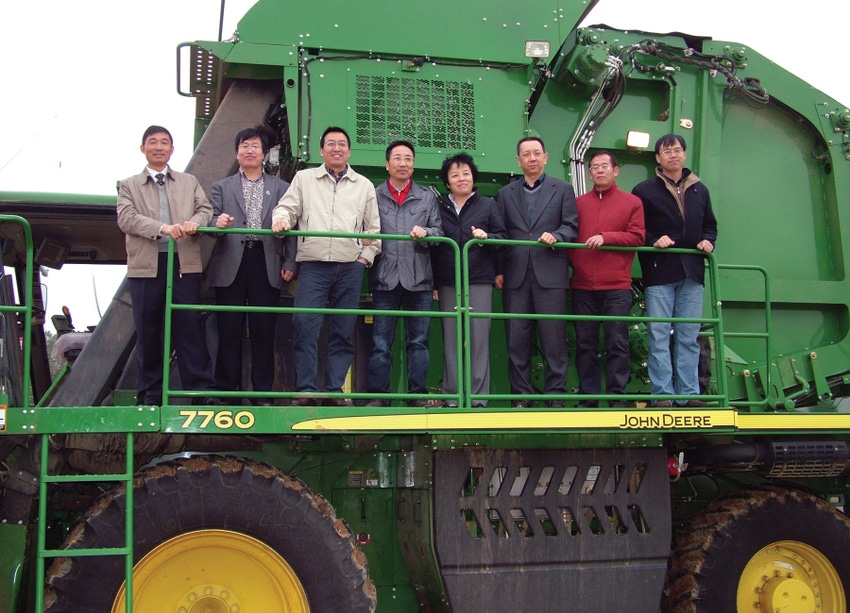
Chinese delegation takes to mechanization
Eight China cotton industry representatives participating in a National Cotton Council tour showed a farmer-like curiosity for the high level of mechanization on a cotton growing, harvesting and ginning operation in west Tennessee.The visit is part of the U.S.-China Cotton Leadership Exchange Program established by the NCC and the Chinese Cotton Association (CCA) in 2006.The visits are in accordance with a signed memorandum of understanding between the NCC and CCA that promises cooperation between the countries’ cotton industries.

For those in agriculture, there’s something about machinery that transcends culture and distance.
Eight China cotton industry representatives demonstrated this common bond during a recent National Cotton Council tour, showing a farmer-like curiosity for the high level of mechanization on a cotton growing, harvesting and ginning operation in west Tennessee.
Of course, a sliver of pecan pie helped too. But more on that later.
On the farm and ginning operation of Richard Kelley, in Burlison, Tenn., the group climbed aboard a cotton picker with on-board module builder and watched as a cotton plant was fed into the machine and seed cotton extracted. They inspected round cotton modules moving down a conveyor ramp as well as the ginning and baling process.
The visit is part of the U.S.-China Cotton Leadership Exchange Program established by the NCC and the Chinese Cotton Association (CCA) in 2006. The visits are in accordance with a signed memorandum of understanding between the NCC and CCA that promises cooperation between the countries’ cotton industries.
Kelley, a cotton producer, ginner, and host for the group, said Chinese interest in American mechanization has piqued in recent years as more Chinese move into the middle class. This has created a labor shortage for large commercial operations in China.
He says the solution for the Chinese is simple – continue to purchase U.S. cotton.
Speaking through an interpreter, Wang Huaigui, president of Cotton Warehousing and Logistics Branch of the China Cotton Association, and leader of the Chinese delegation, said the exchange “is a very good experience for both our countries. The United States is the largest seller of cotton in the world and China is the largest buyer.
“Because we have such a broad expansive relationship, and because we’re looking to further grow this business, we need to further understand each other. Also considering the volatility of cotton prices, and in consideration of the world economy, we do need this kind of exchange. It will help us strive for better cooperation.”
Chinese textile mills prefer spinning U.S. cotton, according to Wang “because it is produced in the largest scale of production with the use of farm mechanization. As a result, there is less artificial fiber and the quality is consistent.”
But there are areas for improvement, Wang said. “For example, certain varieties of cotton seed need to be further improved to reduce the micronaire value.”
Wang said that the Chinese textile industry is still growing, “however, the speed of the growth has been reduced dramatically due to the world economic environment and the rising cost of labor and raw materials.
“The Chinese textile industry is looking for ways to improve and renovate. That’s why we’re looking for good quality cotton in order to compete. This requires the U.S. cotton grower to produce high quality cotton.”
Currently China’s domestic cotton output is 6 million to 8 million tons annually, Wang noted. “The yield is at the mercy of climate and the weather. We have constraints on acreage for cotton production because China is the largest country in the world in terms of population. Grain security is our primary concern.
“In addition, another priority is to grow vegetables to supply the people. So cotton’s acreage will not be expanded dramatically. If the rice price goes up, maybe more farmers will grow rice. This is also a potential threat to cotton acreage.”
Kelley, who visited China in 2010 as part of the exchange program, says the Chinese delegation “asked some hard questions about how we could do better with our cotton fiber. But they still like our cotton. We don’t have any contamination and it’s consistent. “
Kelley said that the Chinese cotton industry has come to a crossroads of sorts. “They know they have to do something different. They’re about to get away from hand picking. They know they’re going to have to mechanize because of the labor problem. The younger generation has moved off the farm. The peasant farmers are the only ones left, and they work their 2-5 acres.”
Kelley says transforming an industry from one in which cotton is handpicked to one picked mechanically is daunting. “That’s only the tip of the iceberg of what has to change. It’s taken the United States 50 years to develop the technology we have today.”
That includes a modern gin’s ability to clean trash from picker-harvested cotton. Many gins in China “don’t have the lint cleaning which can be a problem at the mills,” Kelley said.
One solution, Kelley told the visiting Chinese “is to let us grow and sell you cotton at the best prices you can get, so you can feed your people over there.”
After the tour, the Chinese delegation enjoyed a home-cooked meal and their first-ever taste of pecan pie, prepared by Kelley’s wife, Charlotte, with the help of several local cooks.
About the Author(s)
You May Also Like





